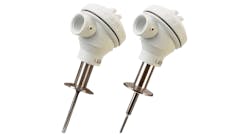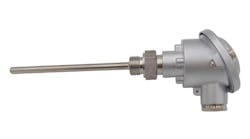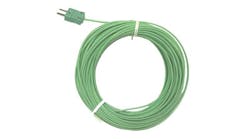This Control Talk column appeared in the July 2022 print edition of Control. To read more Control Talk columns click here or read the Control Talk blog here.
Greg: Distillation column control is key to achieving consistent product purity that meets specification limits without consuming excessive energy. Composition control via either analyzer or inferred prediction is critical. A proportional-integral-derivative (PID) column temperature is typically used if a temperature can be found that correlates well with the product quality or property. Often, the best tray shows large and symmetrical changes in temperature for changes in the manipulated column flow controller setpoint. The reflux or distillate flow is often manipulated to more directly control the material balance split. The manipulation of reboiler or bottoms flow generally has a smaller effect on temperature changes and hence inferred composition except at very large or very small distillate-to-feed ratios seen in high purity columns.
Since the use of the best tray location is critical and can change with operating conditions, it's extremely important that the column have temperature connections at many trays. Sensors should be installed at the best tray and the ones immediately above and below it, as well as at enough other trays to get a good column temperature profile for diagnostics and validation of process models. The sensor should extend into the liquid froth above the tray to maximize the heat transfer coefficient, but should not interfere with column traffic. Intrusion of the thermowell into a downcomer area might cause local flooding. In packed columns, sensor location is more critical due to the possibility that channeling will cause liquid to bypass the sensor. If temperature control doesn't provide the desired end result of column composition control, then a column composition controller can be used to manipulate the setpoint of the column flow controller. An inferential measurement of column composition may be used if an online analyzer isn't available, or to fill in the blanks between analyzer updates that may have delays due to sample transportation and long analyzer cycle times.
Distillation column control can be extremely intimidating to the point of not trying to address or improve opportunities. Here we'll seek to expand our horizons and distill the complexities to the point where we can get involved in providing better product purity. To help us, we have Mark Darby, principal consultant, CMiD Solutions, Houston, who is a principal resource in the ISA Mentor Program and the writer of the PID Signals section and the Signal Characterization annex of the ISA 5.9 Technical Report on PID Algorithms and Performance. Mark is also the author of the July 2019 Control article “Signal filtering: Why and How” and noted the relevance of PID ratio control and column temperature control In the first of his 2013 three-part series of Control Talk columns “Model Predictive Control – Past, Present, and Future, Part 1.”
Mark, how do you decide on the composition control strategy and when to use feedforward or ratio control?
Mark: For a feed change to a column (at the same feed composition) and no steady-state change in product compositions, we know that the following ratios will be maintained: reflux-to-feed, reboiler-to-feed, bottoms-to-feed and distillate-to-feed. These ratios will be achieved if an adequate control scheme is in place. The question then becomes whether feedforward or feed ratio controllers should be used to improve the dynamic response and provide tighter control during feed changes.
For two-product composition control, it’s important to remember that column limitations may prevent both setpoints from being achieved. Therefore, when a limitation is in place, the above-mentioned ratios will not hold. For example, it will not be possible to maintain the reflux-to-feed ratio if a column differential pressure (DP) is limiting and feed increases. In developing the control strategy, one must decide on which product specification (distillate or bottoms) is more important to control when column limitations occur. If a temperature controller is present, the question becomes whether it can be tuned tightly enough to handle feed changes. I’ve often been able to achieve tight temperature control with a two-degree-of-freedom PID controller. If not, I've used a feedforward controller that biases the output of the temperature controller output to the manipulated flow controller setpoint. A similar approach is used if a temperature controller isn't available and the composition controller must directly manipulate the flow rate. If it’s also important to control the other product composition, I’ve used a ratio-to-feed controller that's passed to an override selector, which only implements the resulting flow if no other limitations or overrides are active.
This scheme works fine for normal operation, but different functionality may be needed, for example, for start-up. Greg, I know you’ve addressed this situation.
Greg: Columns are normally started up on ratio control. The temperature controller isn't put in auto until the column has reached operating conditions. A way to provide both functionalities is to use Ratio blocks to implement flow feedforward control, so the operator can readily change the expected ratio, and see the actual ratio of a follower flow (e.g., column reflux flow) to a leader flow (e.g., column feed flow). The leader flow goes into the Ratio block and is multiplied by the Ratio block setpoint. The output of the Ratio block goes through Deadtime and Lead/Lag blocks to become the input to the Bias/Gain block. The gain for the Bias/Gain block is simply 1 with the ratio setting effectively being the feedforward gain. The rules for setting the Deadtime and Lead/Lag blocks are those used for a feedforward summer. The deadtime is the delay in leader flow effect minus the delay in follower flow effect on column temperature. The lead time is the lag in follower loop effect on temperature. The lag time is the lag in leader loop effect on temperature.
The bias of this block is set by a temperature controller output to provide a plus-and-minus correction. The resulting Bias/Gain block output becomes the setpoint of the follower flow controller. An enhanced PID can be used as a composition controller to replace or improve the temperature controller setpoint or action. The Ratio block ratio setpoint may be improved, so the temperature controller correction to the bias is nearly zero. This can be done by an integral-only controller to slowly change the Ratio block ratio setpoint, so the bias approaches zero.
The ISA Mentor Program webinar “Feedforward and Ratio Control” includes a Q&A addendum that offers concepts on ratio control, including automated adaptation of the ratio setpoint or bias to minimize the feedback correction. Webinar Slide 6 provides considerable understanding of when to use feedforward summers vs multipliers. The webinar is available for viewing at www.youtube.com/watch?v=7kt_jFlnlDg.
Mark: Ideally, the effect of the leader flow arrives later than the effect of follower flow, so a positive deadtime setting provides the necessary timing. If the leader flow arrives sooner than the effect of follower flow, the feedforward gain will need to be reduced. If it arrives after the completed correction by feedback control, more harm than good is done by creating a second disturbance. One method to minimize effect is to delay the actual setpoint change of column feed flow controller. The setpoint change without the delay is used as the Ratio block input.
Greg: What can be done to proactively deal with a leader flow controller that has a bad status or is being calibrated?
Mark: The leader flow controller can be put into the remote output mode or output tracking with a valid value before the failure or calibration. This enables the column temperature or composition controller to smoothly adjust the ratio bias as needed. When the leader flow measurement is restored and is valid, there can be a bumpless transition of leader flow controller to automatic. For calibration, this approach requires that the flow be taken off scan (i.e., requiring communication between the instrumentation tech and the inside operator). Otherwise, the follower flow and process can receive a significant bump. As an extra measure of protection, automatic checks/logic can be incorporated into the leader flow status, such as rate of change and high/low limits, so the leader flow status is automatically set to bad/invalid when one of these violations occurs.
Greg: Another difficult and common situation is when an unmeasured disturbance causes a change in column temperature that is in the same direction as the preemptive corrective action of the feedforward signal. For example, there may be a feed composition change accompanying a feed flow change where the unmeasured composition change causes a change in the column temperature that is in the same direction as the feed flow feedforward action, resulting in the flow feedforward increasing the load upset. The FUTURE-VALUE block described in the Control article “Simulation Breeds Innovation” can be used to provide an actual and projected rate of column temperature change from feed flow feedforward and unmeasured disturbances, such as feed composition, to provide a more intelligent gain setting in the Bias/Gain block. The Future-Value block can provide a coordinated and immediate update to rate of change calculations with a good signal-to-noise ratio. Of course, even better would be a measurement of all major disturbances, which in this case is feed composition, to provide a more intelligent and complete feedforward signal.
Not commonly recognized is that level control can be quite challenging with significant consequences. For the often-desired scheme of material split control, where a column temperature controller manipulates the distillate flow, the effect on the column is not seen until the distillate receiver level controller makes a corresponding change in reflux flow. For the change to be quick and complete, the level controller gain needs be larger than what is in the comfort range of most people tuning the level controller (e.g., > 50). If the overhead receiver is a horizontal tank, the cross-sectional area is so large that the resulting integrating process gain is exceptionally low requiring a level controller gain to be exceptionally large (e.g., > 200). Such high controller gains assume a level measurement sensitivity that may only be achieved by a radar level measurement. Any noise in the measurement must be essentially zero because of the amplification of almost imperceptive noise by a large PID gain can cause excessive fluctuations in the manipulated flow. The feedforward of distillate flow to reflux flow or the ratioing the reflux flow to distillate flow with a bias correction by the level controller is helpful for material split control. However, the ability of this control scheme to provide some possible inherent advantages of internal reflux control is endangered. These inherent advantages depend upon the level controller immediately and completely correcting the reflux flow for a change in overhead vapor flow so that the reflux-to-vapor flow ratio is more constant for upsets in vapor flow. For example, if the reflux temperature is cooler, the corresponding decrease in vapor flow will automatically be translated to a change in reflux flow by tight level control.
See the ISA book Advanced Temperature Measurement and Control Second Edition for what is important to achieve good temperature measurements and good column control strategies.
10. A young engineer told the CEO that there were too many presidents. The CEO thanked him profusely and immediately transferred half of the presidents to the plants to configure DCSs.
9. A plant manager found a major design flaw in the control system after carefully reviewing the drawings and immediately authorized the purchase of instruments to solve the problem.
8. After major problems meeting product quality specs, a process engineer said, “the instruments are right, it must be the process that is screwed up”.
7. A person read a whole book on control theory.
6. A vendor refused a purchase order and recommended the purchase of transmitters from a competitor because the vendor’s meters had an excessively high failure rate.
5. A P&ID was drawn with control strategies that didn’t resemble anything ever done before.
4. A vortex shedding flow meter actually achieved the stated 15:1 rangeability.
3. A DCS’s computational power was fully utilized to do advanced control strategies.
2. A book was published that clearly explained how to design the grounding systems for instrumentation.
1. A plant standardized on the type of instruments supplied with a piece of packaged equipment because the quality was superior.

Leaders relevant to this article:





